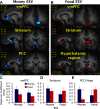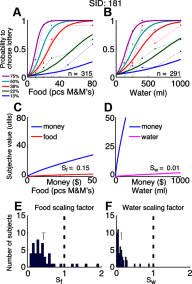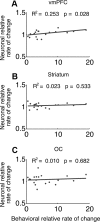Comparing apples and oranges: using reward-specific and reward-general subjective value representation in the brain
- PMID: 21994386
- PMCID: PMC3763520
- DOI: 10.1523/JNEUROSCI.2218-11.2011
Comparing apples and oranges: using reward-specific and reward-general subjective value representation in the brain
Abstract
The ability of human subjects to choose between disparate kinds of rewards suggests that the neural circuits for valuing different reward types must converge. Economic theory suggests that these convergence points represent the subjective values (SVs) of different reward types on a common scale for comparison. To examine these hypotheses and to map the neural circuits for reward valuation we had food and water-deprived subjects make risky choices for money, food, and water both in and out of a brain scanner. We found that risk preferences across reward types were highly correlated; the level of risk aversion an individual showed when choosing among monetary lotteries predicted their risk aversion toward food and water. We also found that partially distinct neural networks represent the SVs of monetary and food rewards and that these distinct networks showed specific convergence points. The hypothalamic region mainly represented the SV for food, and the posterior cingulate cortex mainly represented the SV for money. In both the ventromedial prefrontal cortex (vmPFC) and striatum there was a common area representing the SV of both reward types, but only the vmPFC significantly represented the SVs of money and food on a common scale appropriate for choice in our data set. A correlation analysis demonstrated interactions across money and food valuation areas and the common areas in the vmPFC and striatum. This may suggest that partially distinct valuation networks for different reward types converge on a unified valuation network, which enables a direct comparison between different reward types and hence guides valuation and choice.
Figures









Comment in
-
Extending the study of decision values to cases where options are presented using different sensory modalities.J Neurosci. 2012 Feb 15;32(7):2248-9. doi: 10.1523/JNEUROSCI.6133-11.2012. J Neurosci. 2012. PMID: 22396399 Free PMC article. No abstract available.
References
-
- Arrow KJ. Aspects of the theory of risk-bearing. Helsinki: Yrjö Jahnssonin Säätiö; 1965.
-
- Deichmann R, Gottfried JA, Hutton C, Turner R. Optimized EPI for fMRI studies of the orbitofrontal cortex. Neuroimage. 2003;19:430–441. - PubMed
-
- Del Parigi A, Gautier JF, Chen K, Salbe AD, Ravussin E, Reiman E, Tataranni PA. Neuroimaging and obesity: mapping the brain responses to hunger and satiation in humans using positron emission tomography. Ann N Y Acad Sci. 2002;967:389–397. - PubMed
Publication types
MeSH terms
Substances
Grants and funding
LinkOut - more resources
Full Text Sources
